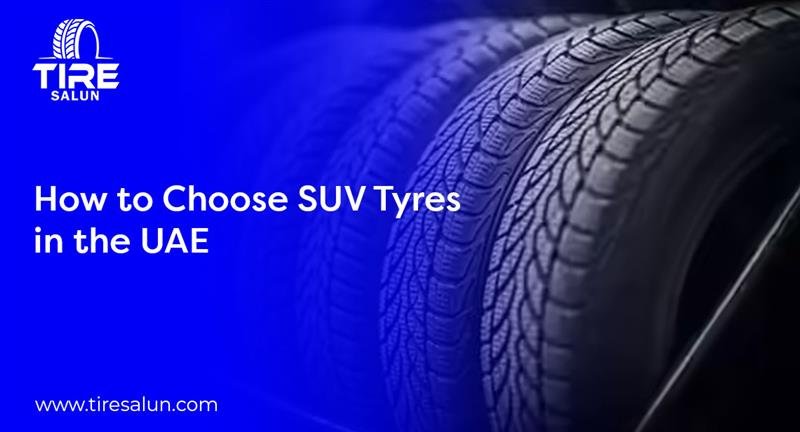Finding the right SUV tyres UAE is a research project; your choice impacts the safety, fuel economy, and that in which you drive from the concrete of Sheikh Zayed Road to the sandy dunes. Also, in this guide, we will go over how to match tire type to your driving style, how to read key features like tread depth, and which to choose that is built for the Gulf’s tough climate.
SUV Tyres UAE: Why a One Size Fits All approach doesn’t work.
SUV tyres UAE, which sees great variation from searing heat to very dry desert conditions, tires that do well in Europe or North America may not perform well here. What you want are compounds that stay flexible at over 40° Celsius, reinforced sidewalls for better resistance to curbing impact, and tread designs that push the sand away instead of trapping it.
1. Start in your primary driving environment
Most SUV drivers split time between these two primary terrains:
| Driving Mode | Best Tyre Choice | Primary Benefit |
| Daily travel cross country driving | Highway tyres | Reduced roll resistance which means better fuel economy. |
| Weekend off road trips | Off-road tyres | Deep tread and stone ejector grooves for grip |
In a ratio of 80/20 in favor of the office-to-dune bashing, you’re better off-road tyres, which you can throw off a little for some off-road action instead of using heavy all-terrain tires that do a disservice to pavement comfort.
2. Check Tread Depth – your best defense against hydroplaning
The standard issue for new highway tyres is 8- 9 mm of tread; as for off-road tyres, we see up to 12 mm. In the UAE’s short and intense rain events, which are few but dramatic, the deeper grooves in the tires do a better job at water evacuation and reducing hydroplaning risk. At each service interval, check your tread depth; when you get down to 3 mm, it is a good idea to start looking at replacements. For quality Pirelli Tyres and services, you can always visit us at Tiresalun to ensure your vehicle is prepared for all road conditions.
3. Check out the Durability Markers
Extreme temperatures cause the rubber to break down faster. Look for:
UTQG, which A withstands at 115 °C in lab tests.
GVWR of your SUV, which the load index must meet or exceed.
Reinforced sidewalls, which may be marked “XL” or “Extra Load” for resistance to potholes in new construction zones.
Tire compounds, which are silica-enriched, are also reported to stay flexible instead of cracking in the sun.
4. Balance your ride with road noise
Search out manufacturers that feature variable pitch or “silent groove” designs.
5. Do not ignore size and speed ratings
Upsizing for looks can damage handling if you go beyond what your wheel arches can handle or you choose a load index that is below what the factory says. Stay within 3% of the O.E. rolling diameter and confirm:
Speed rating of over 210 km/h for UAE highways.
Load capacity of at least 109, which is 1030 kg on mid-size SUVs.
6. Tyre rotation and seasonal pressure checks
Desert excursions may require that you stop at 16-18 psi for flotation and then reinflate for highway speeds.
FAQs
Q1: Which are the top SUV tyres UAE for?
A: Find high-end highway tyres like the Michelin Latitude Tour HP and Bridgestone Dueler H/L, which have a T temperature rating, silica in the compound, and a 400-plus tread wear UTQG. These features see the rubber do well at 50° C asphalt while also preserving ride comfort.
Q2: Are your tires for off-road use suitable for a daily city commute?
A: They are safe but not perfect. Off-road tires trade in fuel efficiency and increase road noise, and also may wear out faster on smooth pavement. If you don’t put in over 40% of your driving on sand or gravel, go with highway SUV tyres UAE and only use lower pressures when you hit the trails.
Q3: At what frequency do I need to change SUV tyres UAE in the hot climate of the UAE?
A: Heat increases oxidation, so even if the tread depth is fine, get new tires every four years or 60,000 km, whichever is soon. Also, check sidewalls for micro-cracks, which are a telltale sign the compound is hardened.
Q4: Does tire wear play a role in how we brake on wet roads in Dubai?
A: Yes. Also reported is that those that have 4 mm tread do break 15% farther at the time of testing as compared to new tires on wet asphalt. What we see is that as soon as you go below 3 mm in tread depth, the risk of hydroplaning greatly increases, which is very much the case right after November rainstorms.
Final Thoughts
Choosing the best SUV tyres UAE is a matter of honest self-assessment of your driving habits, getting to know key specs like tread depth, durability, ride comfort, and, of course, adhering to what the manufacturer says about size and rotation. Put your money wisely, and you will see better results in terms of quiet rides, better fuel economy, and safe adventures, whether you are taking on Jebel Jais or the open road along the E11. For personal advice or a tire change today, go to TireSalun.com or call our experts for a free fitment consultation. Your SUV and passengers will thank you.


